Delhi Station News: What was first believed to be a tragic stampede at New Delhi Railway Station that claimed 18 lives during the Maha Kumbh rush in February was, in fact, sparked by a fallen headload, Union Railway Minister Ashwini Vaishnaw told the Rajya Sabha on Friday.
Responding to a query raised by Samajwadi Party MP Ramji Lal Suman, the minister referred to the findings of a high-level inquiry committee that probed the events leading up to the tragedy on 15 February. He stated that a large bag or bundle, referred to as a “big headload”, fell from one of the passengers, setting off a domino effect that caused people to trip and fall on the stairs connecting platforms 14 and 15.
‘Pressure Passed On To The Stairs’
“There was a gradual increase of passenger density on the foot overbridge (FOB) after 8:15 pm. Many were carrying heavy loads on their heads, obstructing smooth movement. One such headload fell, causing pressure to shift toward the stairs,” said Vaishnaw in a written reply. “This led to passengers tripping at 8:48 pm on FOB-3. Consequently, people fell on each other.”
The incident happened during peak rush for trains bound to Prayagraj, where the 45-day Maha Kumbh Mela was in full swing. Around 49,000 general tickets were sold on the day, 13,000 more than the average, leading to overcrowding across key platforms.
While the public had widely termed the incident a stampede, the minister notably did not use the word in his official reply. However, the sheer scale of the tragedy had prompted a post by Prime Minister Narendra Modi on X that night, expressing deep distress over the loss of lives.
Compensation and Crowd Management Measures
Eighteen passengers died and 15 others were injured in the chaos. The families of the deceased received a compensation of Rs 10 lakh each, while those seriously injured were given Rs 2.5 lakh. Victims with minor injuries were awarded Rs 1 lakh. “A total of Rs 2.01 crore has been paid to 33 victims and their families,” the minister informed.
Vaishnaw also emphasised that crowd control measures were in place on the day of the tragedy. In light of the incident, the railways have now reinforced those steps. These include establishing permanent holding areas, introducing access control at 73 major stations, widening foot overbridges, installing additional CCTV cameras, and setting up ‘war rooms’ for real-time crowd monitoring.
With religious gatherings like the Maha Kumbh drawing millions, the minister acknowledged the pressing need for more robust safety mechanisms. As India’s rail network continues to handle record footfalls during festivals and pilgrimages, the focus on passenger safety remains paramount.
